This website uses cookies so that we can provide you with the best user experience possible. Cookie information is stored in your browser and performs functions such as recognising you when you return to our website and helping our team to understand which sections of the website you find most interesting and useful.
 Image copyright NASA / Andy Saunders / Stephen Slater
Image copyright NASA / Andy Saunders / Stephen SlaterImage enhancement techniques have been used to reveal life aboard Nasa's stricken Apollo 13 spacecraft in unprecedented detail.
Fifty years ago, the craft suffered an explosion that jeopardised the lives of the three astronauts aboard.
Unsurprisingly, given they were locked in a fight for survival, relatively few onboard images were taken.
But imaging specialist Andy Saunders created sharp stills from low-quality 16mm film shot by the crew.
One of the techniques used by Mr Saunders is known as "stacking", in which many frames are assembled on top of each other to improve the image's detail.
Crewed by Nasa astronauts Jim Lovell, Jack Swigert and Fred Haise, Apollo 13 was supposed to be the third American mission to land on the lunar surface. During the journey to the Moon, an explosion in the service module allowed some of the spacecraft's oxygen to leak out into space.
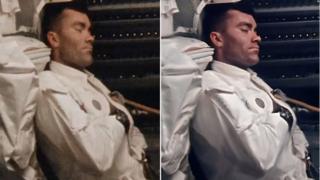 Image copyright NASA / Andy Saunders / Stephen Slater
Image copyright NASA / Andy Saunders / Stephen SlaterAstronaut Jack Swigert reported the accident to ground controllers with the immortal, and much misquoted, phrase: "Okay, Houston, we've had a problem here."
The part of the Apollo spacecraft designed to return the astronauts through Earth's atmosphere after the mission - the command module (CM) - had to be shut down to conserve its remaining resources for re-entry. The crew had to use the lunar module (LM) - also known as the lander - as a lifeboat.
The lander's life support systems were designed for two astronauts living for two days on the lunar surface. Experts at Nasa's Johnson Space Center in Houston, Texas, had to figure out a way to stretch its resources so that it could support three crew members for four days.
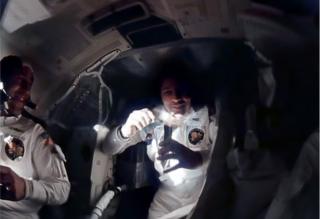 Image copyright NASA / Andy Saunders / Stephen Slater
Image copyright NASA / Andy Saunders / Stephen SlaterLovell, Swigert and Haise looped around the Moon and back to Earth in a cold, damp module with limited drinking water. Luckily, the improvised plan to get them back was a success, and the three astronauts splashed down safely into the Pacific Ocean.
Despite their grave predicament, the crew used a 16mm film camera to record scenes of life aboard the spacecraft. But the footage is of low quality by today's standards.
It is this footage that Mr Saunders used as the basis of his enhanced images, which reveal new insights into the crew's fight for survival aboard the damaged spacecraft.
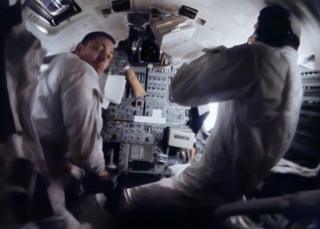 Image copyright NASA / Andy Saunders / Stephen Slater
Image copyright NASA / Andy Saunders / Stephen SlaterA composite panorama of the lunar module "lifeboat" shows Commander Jim Lovell's attempts at normality by selecting some music on a tape player, while command module pilot Jack Swigert takes a nap in the storage area.
Another, dubbed "Happy crew" by Mr Saunders, captures Lovell and Swigert in apparent high spirits.
"One striking thing about the 16mm footage is how calm the crew appear, given the grave nature of the situation, the conditions, and the critical mission tasks that lay ahead," Mr Saunders told BBC News. "This perhaps belies their true feelings as we know that, in reality, the crew doubted if they would make it home alive."
The crew members are eating in the scene. The freeze-dried food relied on mixing it with hot water, but only cold water was available. Lovell later admitted he had eaten little in the days following the accident, losing 6kg (14lb) in weight.
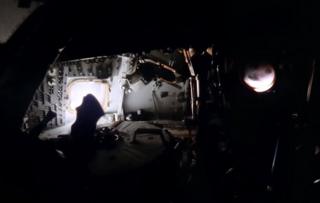 Image copyright NASA / Andy Saunders / Stephen Slater
Image copyright NASA / Andy Saunders / Stephen SlaterA panorama of the dark, powered-down command module was produced from footage shot by Fred Haise when he went to check it out before the rest of the crew moved back in for the risky return through the Earth's atmosphere.
In an interview for a new Nasa documentary called Apollo 13: Home Safe, Haise recalls how damp it was in the CM. The astronauts had to wipe down the panels with towels because of a concern that the water could cause an electrical short that could lead to a fire. This would have been catastrophic in the spacecraft's enclosed environment.
Two concepts are important for understanding the technique used to process the images: signal - the parts of the image that are desirable to keep - and noise - the unwanted parts of the image. Mr Saunders started by stacking different frames of the same scene on top of one another.
"It all hinges on the principle that stacking images improves the signal-to-noise ratio," Mr Saunders explained.
He added: "As the noise in each frame is truly random, then stacking multiple frames of the same scene on top of each other and averaging out the levels of each aligned pixel has the effect of identifying and reducing noise whilst maintaining signal (the signal will be present on all frames)."
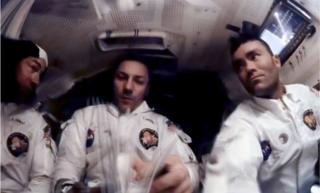 Image copyright NASA / Andy Saunders / Stephen Slater
Image copyright NASA / Andy Saunders / Stephen SlaterThis ultimately boosts the detail, along with overall image quality, making it more "photo-like".
But because he was dealing with moving pictures, Mr Saunders had to re-align multiple parts of the image, combining all the results into one final picture. These combined images are made up of more than 20 sections stitched together, with each section consisting of a stack of up to 75 separate processed frames, revealing the crew and spacecraft in unprecedented detail.
Using commercial software, he then enhanced the photos; adjusting the contrast, correcting the colour and removing some of the "fish-eye" effect resulting from the wide angle lens that was needed to capture events in such a confined space.
More restored images from the Apollo missions, including those from the Apollo 13, can be viewed on Andy Saunders' Twitter feed.
Follow Paul on Twitter.



 Africana55 Radio
Africana55 Radio 
